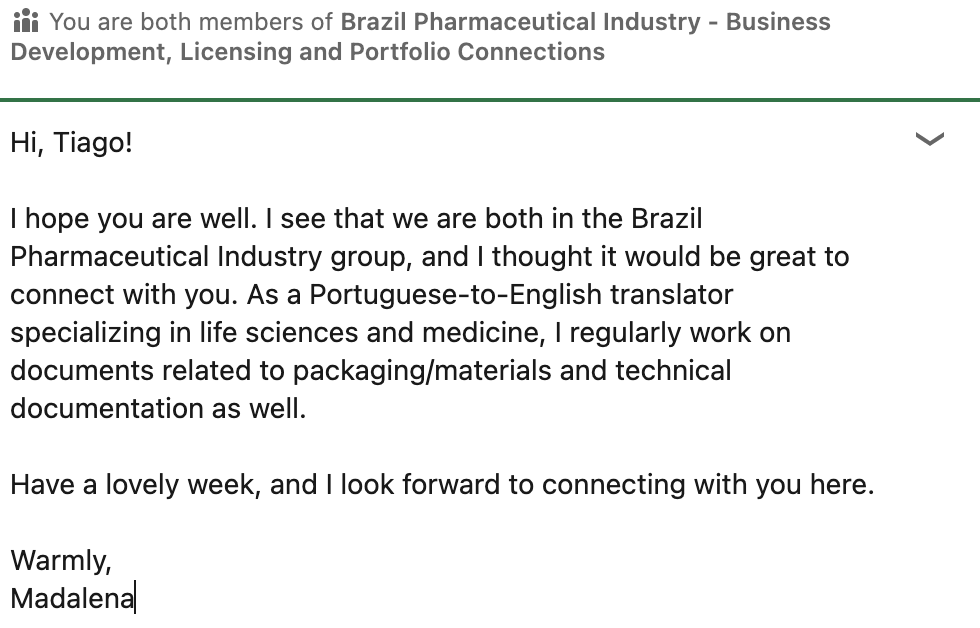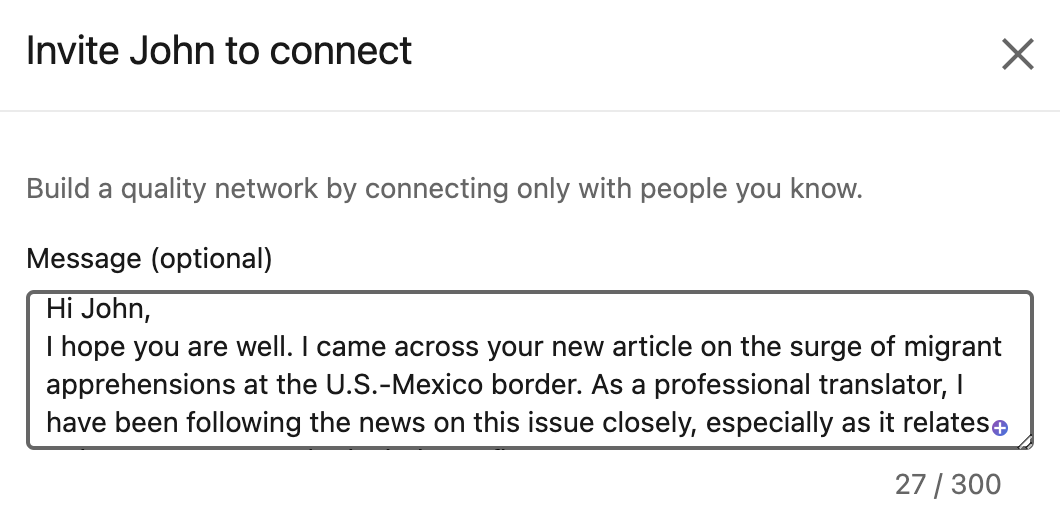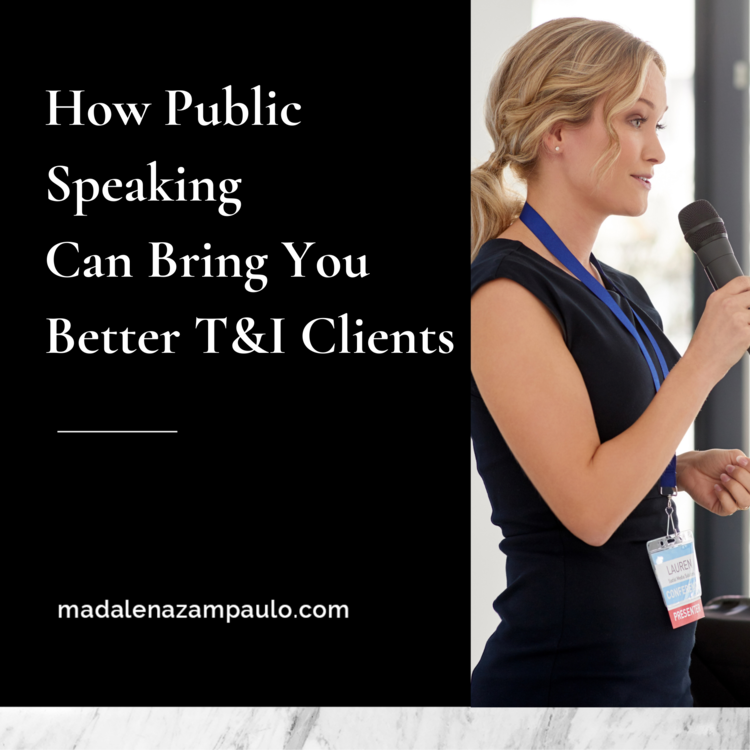How to Reach Out to Potential Translation or Interpreting Clients on LinkedIn
Sending warm emails or direct messages to potential clients can sometimes feel overwhelming.
You might ask yourself, "What do I say? How much should I write? Should I offer my services in the first message or wait until the conversation has flowed for a while?"
You may have even stalled out before you think of what to say and wonder, "Why would this person want to connect with me at all?"
I get it. Networking, in general, can be nerve-racking. You never know how the person on the other end is going to receive your message.
But when it comes to online networking, LinkedIn is exactly the place where people are expecting to network. If they weren't, they wouldn’t be using the platform.
With more than 700 million users in over 200 countries, LinkedIn is the place many people turn when looking for a professional service provider. It is a powerhouse of a search engine to find professionals in just about any field.
So, rather than wonder if your connection request will land well with potential clients and the specifics of what you're going to say, start by asking "What value do I offer clients and those in my network?" From there, the rest will flow.
Check your mindset
Try to remove the emotion of putting yourself out there for a moment and think about this. If you know that what you offer clients in terms of your expertise and services is valuable—your services help people overcome challenges and reach their goals—not only will it be easier to approach clients, but you'll have a better idea of what to say in your initial messages to prospects.
I've had colleagues ask me, "What if a client gets annoyed when I reach out to them? What if they reject me or don't reply at all?"
If you're already asking yourself these questions before you even start, it's time for a mindset shift.
Related: 6 Ways to Stop Self-Sabotaging Your Online Marketing Efforts and 5 Mindset Shifts to Create a Stronger Online Presence in 2021
Just like any marketing strategy, you have to take some chances. Sure, there will be some people who don't reply. There might even be some people who are less than friendly. But that's true of any social media network. LinkedIn is currently the top platform for freelance professionals to gain more work with the right clients, and it's never been easier to find and connect with them.
Don't try to sell right away
Let's take the pressure off a bit. You don't need to sell or pitch to a new LinkedIn connection any more than you do to someone you meet in the grocery store line. Starting a conversation with a pitch can quickly turn the other person off.
Instead, keep in mind the goal of LinkedIn and the reason why your prospects are using the platform in the first place. They want to grow their network. They probably even want to do business. But no one joins LinkedIn to receive sales pitches in their direct messages.
A connection request is simply the first step in a conversation. The idea is to build a relationship and trust, to get to know your potential clients better, and to share your expertise in a natural way, not a pushy one. So, take a deep breath and remember that a connection request doesn't mean the other person has to make a long-term commitment. Rather, you want to know more about this person (and hopefully they'll be intrigued enough by your request and your profile to feel the same). But if they don't, no big deal.
Think of LinkedIn as a huge networking event, minus the awkward handshakes and having to balance a drink and a plate of food while you make small talk. If someone doesn't respond or doesn't accept your invitation to connect, move on to someone else who is more interested in your request (and, eventually, in your services).
The beauty of this platform is that you have the ability to network with more people online than you ever could in person. People who need your services and value your work. People who know other people who need your services and value your work. So, free yourself of any pressure you're feeling about having to sell, and start thinking about how to build relationships.
Give potential clients a reason to connect with you
The most important thing to mention when requesting to connect with someone on LinkedIn is why you want to connect. So many people fail to hit the "Add a note" button when sending a new request. Make sure to personalize your request before you hit "Send."
Omitting this simple step of the process could mean the difference between someone accepting your request or deleting it. Take it from me. I currently have 150+ pending requests from people who didn't tell me why they want to connect with me. Don't be that person.
Create a few templates and start requesting to connect
Some of the pressure many translators and interpreters feel when sending connection requests is related to what they will say in their message to prospective clients. This is where having a few different message templates can come in handy.
When you're ready to make a habit of sitting down to send new connection requests, don't let not knowing what to say stop you in your tracks. Here are three template messages you can use to get the ball rolling and start building momentum.
Template 1: The "We have a common connection" connection request
This is perhaps the easiest way to connect with a potential client. When you already have friends or acquaintances in common, you can ask your current connection to introduce you to the other person, or you can mention them when you make the request directly. This type of request is especially useful when you want to connect with more than one person at a company or organization.
This type of request is simple and gives the recipient an idea of why you think it's a good idea to be in touch. Make sure to mention the other person by name and how you know them. If you've worked with them for a while, you might even slip in some information about what type of work you've done together.
Template 2: The "We have something in common" connection request
Another way to build trust when sending a connection request is to mention something you have in common with the other person. Perhaps you went to the same university or worked at the same company years ago but never met each other. Or, better yet, maybe you belong to the same Group on LinkedIn. Take the time to scan the members of your LinkedIn Groups to see who you might want to start building an informal relationship with. You never know if that person could become your next client!
Template 3: The "I saw you did something amazing" connection request
This strategy is a bit different because you have to be paying attention to something your potential clients have achieved. One easy way to do this is to set up Google Alerts for individuals or companies you'd like to partner with. When you receive an alert about an article someone wrote or an award they received, you can use this information to congratulate them in your message. Remember to be sincere, however. If you're not really interested in or don't fully understand what this person has achieved, it might show in your invitation. Keep your message short and succinct but always genuine.
All of these request templates are simple and easy to draft in just a few minutes. They have served me very well over the past few years, and I continue to tweak and refine them depending on the recipient.
Remember to be brief (the current limit for connection invitation messages is no more than 300 characters). Get to the point quickly and say something that will appeal to the recipient so they'll be intrigued and willing to connect with you.
Don't forget the follow-up
Once someone accepts your connection request, it's important to thank them for accepting. A simple message will do. But that's not where it ends! The real magic happens in the follow-up.
How soon should you follow up with a new LinkedIn connection after they accept your invitation to connect?
There's no formula to the amount of time you should wait to follow up with a new connection, but if I were to choose a certain amount of time to wait before you send your next message, I would say at least two weeks but no longer than five or six. You don't want to come across as overly eager, but you also don't want your new connection to forget who you are. Try to follow up in a reasonable amount of time after your first interaction. For long-term interactions and to stay top of mind, shoot for once a quarter to be sure you're not overdoing it.
What do you say in your follow-up message?
The answer to this question largely depends on your previous interactions with your new connection. If you had a conversation with them about a specific topic, you might consider sending them a news article that is relevant or that they might find interesting. Here's an example:
Whatever you choose to say in your follow-up, make sure it's relevant to the recipient. You might have to get creative with this, but that's half the fun of long-term relationship-building!
How do you know when it's okay to offer your services?
Most people will tell you if they would like to know more about your work or if they know someone who might need your services. The more you show up with value and sincerity, the more likely you are to build trust and likability with connections who could eventually turn into clients or who refer you to others they know.
When it comes time to talk about potential projects, take the conversation offline (i.e., not on LinkedIn). Set up a call via Zoom or by phone and have a real conversation about what it might look like to work together.
Pay attention to people who view your profile or request to connect with you, too
When other people view your profile or request to connect with you, this is a sign they're interested in what you do. Follow up with these people and see what you have in common or if they have a problem you might help them solve. Don't just accept their request and move on. Take time to learn about them and why they were intrigued to visit your profile.
Continue to nurture the potential client relationships you build through new LinkedIn connection requests. Set Google alerts for the people and companies or organizations you're interested in working with so you can be aware of any news that would make a good follow-up (congratulate them on a new award, get notified if they change jobs/positions, etc.) and follow their LinkedIn updates, too. Use these as a way to keep the conversation going.
Finally, don't be shy. Remember that the only way you're going to bother someone is if you have nothing of substance to say or if you start pitching your services to them as soon as they agree to connect. LinkedIn is about building relationships, which is what long-term partnerships are all about.
What tips do you have for connecting with potential clients on LinkedIn? How do you keep the conversation going and build a relationship over time?









